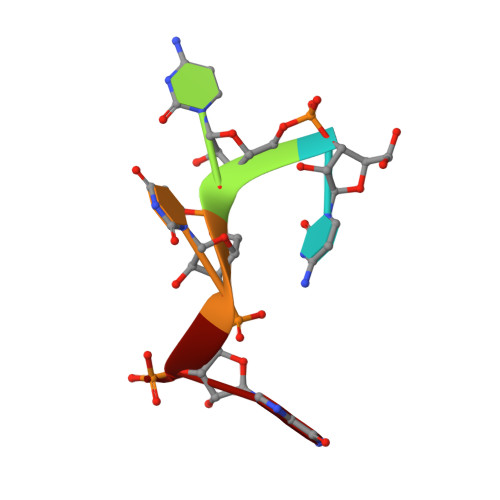Structures of bacterial polynucleotide kinase in a michaelis complex with nucleoside triphosphate (NTP)-Mg2+ and 5'-OH RNA and a mixed substrate-product complex with NTP-Mg2+ and a 5'-phosphorylated oligonucleotide.
Das, U., Wang, L.K., Smith, P., Munir, A., Shuman, S.(2014) J Bacteriol 196: 4285-4292
- PubMed: 25266383
- DOI: https://doi.org/10.1128/JB.02197-14
- Primary Citation of Related Structures:
4QM6, 4QM7 - PubMed Abstract:
Clostridium thermocellum polynucleotide kinase (CthPnk), the 5'-end-healing module of a bacterial RNA repair system, catalyzes reversible phosphoryl transfer from a nucleoside triphosphate (NTP) donor to a 5'-OH polynucleotide acceptor, either DNA or RNA. Here we report the 1.5-Å crystal structure of CthPnk-D38N in a Michaelis complex with GTP-Mg(2+) and a 5'-OH RNA oligonucleotide. The RNA-binding mode of CthPnk is different from that of the metazoan RNA kinase Clp1. CthPnk makes hydrogen bonds to the ribose 2'-hydroxyls of the 5' terminal nucleoside, via Gln51, and the penultimate nucleoside, via Gln83. The 5'-terminal nucleobase is sandwiched by Gln51 and Val129. Mutating Gln51 or Val129 to alanine reduced kinase specific activity 3-fold. Ser37 and Thr80 donate functionally redundant hydrogen bonds to the terminal phosphodiester; a S37A-T80A double mutation reduced kinase activity 50-fold. Crystallization of catalytically active CthPnk with GTP-Mg(2+) and a 5'-OH DNA yielded a mixed substrate-product complex with GTP-Mg(2+) and 5'-PO4 DNA, wherein the product 5' phosphate group is displaced by the NTP γ phosphate and the local architecture of the acceptor site is perturbed.
Organizational Affiliation:
Molecular Biology Program, Sloan-Kettering Institute, New York, New York, USA.



















